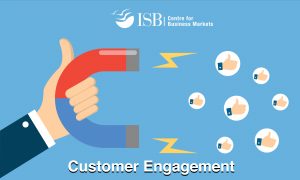
Masterclass by Prof. D.V.R.Seshadri,
Clinical Professor in Marketing Area at Indian School of Business,
Mr. Rajesh Pandit,
Management Consultant, and
Prof. Philip C. Zerrillo,
Deputy Dean, Corporate Relations and Professor in Marketing Area (Practise) at ISB
Date: Thursday July 30, 2020
Compiled by Astha Sharma, Senior Manager, ISB-Centre for Business Markets (CBM)
What do companies want? Higher revenues, higher profitability, satisfied customers, right brand image, which lead to “growth.” The answer to converting this wish-list to reality is Customer Engagement. There are many benefits of engaging with your customer. You get an increased share of the customer’s wallet; get better results out of your incentivized referral programs; the customers endorse you on social media, even without any incentives boosting your organic presence; and finally provide you with meaningful feedback that can be used to improve your offerings or create a new offering altogether.
These benefits of customer engagement increase the company’s revenues, which can be reinvested to profile the profitable customers and engage with them more through different channels.
Word of caution: In today’s social media age, the same vicious cycle can also turn to the negative side; hence companies must watch out for dissatisfied customers and engage with them suitably to avoid negative brand image on social media.
Engaging with customers needs a lot of investment, but the benefits of the same can also be monetized. Different metrics that are used to quantify the efficacy of your customer engagement efforts are:
1. Customer Lifetime Value (CLV): Customers buy more from you more and for a longer time.
The other indirectly quantifiable benefits are:
1. Customer Referral Value (CRV): Your customers getting you more customers from your incentivized referral schemes
2. Customer Influence Value (CIV): Customers talking good about you in different forums, leveraging social media
3. Customer Knowledge Value (CKV): Customers giving helpful feedback, knowing that you value their feedback, which can be used to enhance your market offerings through innovation
These are the components of “Customer Engagement Value”. However, to drive customers to your company in the first place, you will have to invest in creating a powerful brand, i.e., you had invested to create high Customer Brand Value (CBV), which is essential to gain differentiation in today’s crowded space.
Two examples of the large legacy companies that have successfully engaged their customers and improved their revenues and profitability are Tata Steel and companies in Aditya Birla Group.
In both these examples, the companies have engaged with the chosen customers (who have been profiled through rigorous criteria) and as a consequence, managed to escape the vicious spiral of commoditization. This has helped them create a non-price agenda in their discussions with their customers. They have been able to capture and communicate the value of their offerings, which was otherwise getting overlooked, since in the absence of powerful ideas for customer engagement, the discussion quickly degenerates into price negotiations.
Each company will need to develop its unique process for engaging with customers depending on their internal processes and culture.
Until recently, customer engagement has been driven by the company’s employees and enabled by technology. With the significant advancement in technology, technology can be used to drive customer engagement. While technology has been increasingly used to engage customers in B2Cmarkets, similar trends are visible in business-to-business (B2B) markets as well. Examples include deploying Virtual Reality, and the Internet of Things. These will enable more high-quality information flow in the supply chain, which can create a lot of value for the customer.
Companies also need to use design thinking to design their customer engagement processes. An example of effectively understanding your customer and developing your offering is Gillette Guard. While Gillette designed Vector for Indian Men living outside the metro cities, the product failed to generate revenues for the company. Gillette then sent a team to India to understand this specific customer segment and design a product that suited them. This led to the introduction of Gillette Guard, which became one of the best-selling products in its category.
The ultimate goal of customer engagement is to move away from a transactional relationship with the customers and become their trusted advisers. While this journey is time-taking and essential, companies need to realize that not all customers want to be engaged. Customer engagement and the possibility of becoming a customer’s trusted adviser is possible only when customers face considerable risk in terms of time, finances, or psychology. In such a scenario, you can offer your experience and knowledge to create trust with the customer and transition to become a trusted advisor to the customer.
Suggested Reading: If you wish to learn more about this topic and learn how to calculate different measures of customer engagement, please deep dive into the book “Profitable Customer Engagement: Concepts, Metrics, and Strategies,” by Dr. V. Kumar.
This session also concludes our series of masterclasses on the broad theme of “Customer Focus.” Do refer to our other blogs to gain complete insight on this subject.

